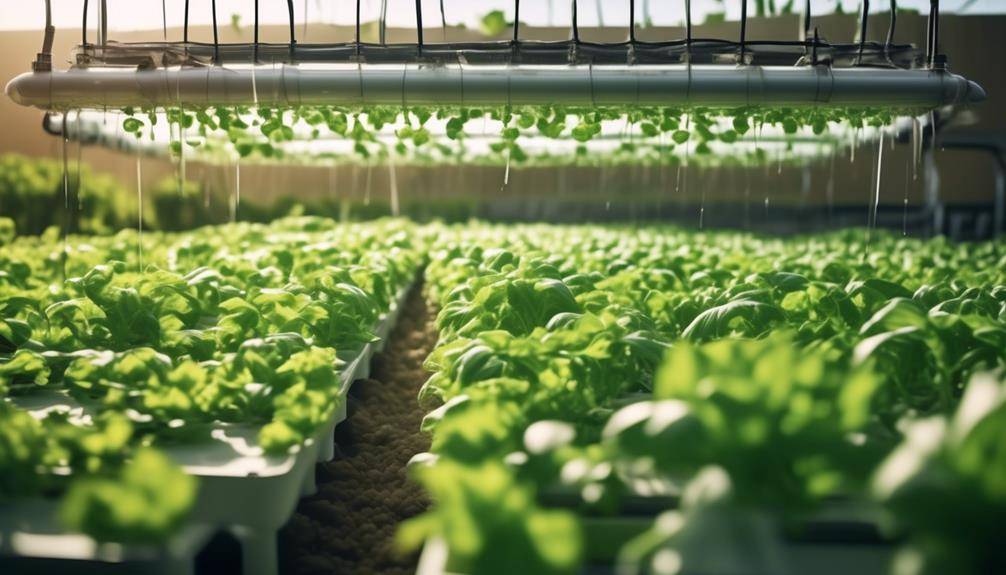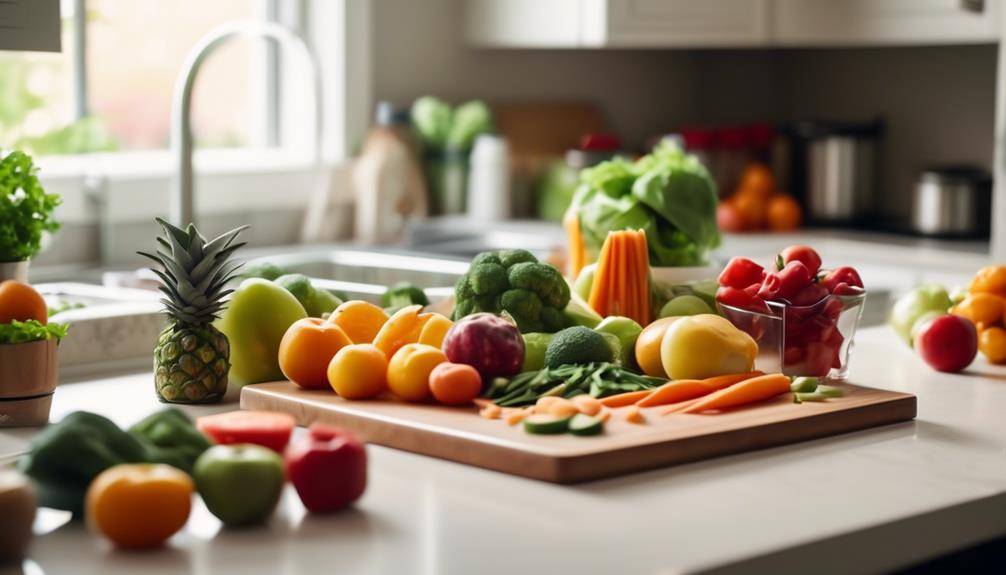New Hydroponics Solutions For Drought-Prone Farming

Hydroponics Solutions For Drought; In a world where the earth’s arid landscapes symbolize the harsh reality of drought, you find yourself seeking a solution to sustain your farming endeavors. Hydroponics, a revolutionary approach to cultivation, offers a glimmer of hope amidst the parched fields. But how does it work? And what makes it a viable option for drought-prone regions? The answers lie within the realm of hydroponics solutions, a realm where water conservation, optimal nutrient delivery, and remarkable yields converge. Prepare to uncover the secrets of this innovative farming technique, as we embark on a journey to explore the potential of hydroponics in mitigating the challenges posed by drought.
The Impact of Drought on Farming
Drought severely affects agricultural productivity, causing significant yield losses and economic hardships for farmers. The impact of climate change has further exacerbated this issue, as droughts become more frequent and intense in many regions around the world. It is essential to understand the consequences of drought on farming and explore strategies for drought mitigation.
One of the primary impacts of drought on farming is the reduction in crop yields. Plants require water to grow and develop properly, and a lack of water during critical growth stages can lead to stunted growth and lower overall productivity. Studies have shown that drought can cause yield losses ranging from 10% to 50%, depending on the severity and duration of the drought event.
In addition to yield losses, drought also has significant economic consequences for farmers. The lack of water not only affects crop production but also reduces the availability of water for livestock and irrigation purposes. Farmers may face increased costs for purchasing water or feed for their animals, leading to financial strain and potential bankruptcy. Moreover, the overall decline in agricultural productivity due to drought can have a ripple effect on the entire food supply chain, leading to higher food prices and food insecurity for vulnerable populations.
To mitigate the impact of drought on farming, various strategies can be employed. Improving water management practices, such as rainwater harvesting and efficient irrigation systems, can help optimize water use and minimize losses. Implementing soil conservation techniques, such as mulching and cover cropping, can enhance soil moisture retention and reduce evaporation. Additionally, promoting climate-smart agriculture practices, such as crop diversification and the use of drought-tolerant varieties, can enhance resilience to drought events.
Understanding Hydroponics Basics
To understand hydroponics basics, let’s explore the benefits it offers. Hydroponics allows for precise control over nutrient levels, resulting in faster growth and higher yields compared to traditional soil farming. Additionally, hydroponics eliminates the need for soil, reducing the risk of diseases and pests. Understanding the components of a hydroponics system is crucial, including the reservoir, pump, grow tray, and nutrient solution, as they work together to create an optimal growing environment.
Benefits of Hydroponics
Hydroponics offers a range of benefits that make it an innovative and efficient solution for modern farming practices. By adopting hydroponics, you can maximize your yield while overcoming the challenges of drought-prone farming. Here are some key benefits of hydroponics:
- Water efficiency: Hydroponics uses up to 90% less water compared to traditional soil-based farming methods, helping you conserve this precious resource.
- Space optimization: With hydroponics, you can grow plants vertically, making efficient use of limited space and increasing your overall crop yield.
- Nutrient control: By precisely controlling the nutrient solution, hydroponics allows plants to receive the optimal amount of nutrients, resulting in healthier and more productive crops.
- Pest and disease management: The controlled environment of hydroponics minimizes the risk of pests and diseases, reducing the need for chemical pesticides and ensuring healthier plants.
- Year-round cultivation: With hydroponics, you can grow crops all year round, regardless of weather conditions, enabling consistent production and a steady income.
Hydroponics System Components
One key aspect of hydroponics is understanding the components that make up the system for efficient and successful cultivation. Proper hydroponics system maintenance is crucial in ensuring optimal plant growth and maximizing yield. The main components of a hydroponics system include a reservoir, a water pump, a nutrient solution, a delivery system, and a growing medium. The reservoir holds the nutrient solution, which is constantly circulated by the water pump.
The delivery system, consisting of tubes or channels, transports the nutrient solution to the plant roots. The growing medium, such as perlite or rockwool, provides support for the plants and helps to optimize nutrient uptake. Regular monitoring and adjustment of the nutrient solution’s pH and nutrient levels are essential for maintaining a healthy hydroponic system and ensuring that plants receive the necessary nutrients for growth. By understanding and properly maintaining these components, you can optimize nutrient uptake and achieve successful hydroponic cultivation.
Water Conservation Benefits of Hydroponics
Implementing hydroponics systems offers significant water conservation benefits, making it a viable solution for drought-prone farming. By adopting this method, you can minimize water usage while maximizing crop production. Here are the water conservation benefits of hydroponics:
- Efficient use of water: Hydroponic systems use up to 90% less water compared to traditional soil-based farming methods. The water is recirculated within the system, reducing wastage and ensuring that every drop is utilized effectively.
- Reduced evaporation: Hydroponics eliminates the need for irrigation, which can lead to significant evaporation losses. By providing water directly to the plant roots in a controlled environment, evaporation is minimized, conserving precious water resources.
- Precise nutrient delivery: Hydroponics allows for precise control over the nutrient solution, ensuring that plants receive the necessary nutrients without any excess. This targeted approach prevents nutrient leaching and minimizes water requirements.
- Elimination of runoff: In traditional farming, excessive irrigation can cause runoff, leading to water pollution and nutrient loss. Hydroponics eliminates this issue as the water is contained within the system, preventing any runoff and protecting water quality.
- Water recycling: Hydroponic systems enable the collection and reuse of water, reducing the need for constant freshwater input. This closed-loop system not only conserves water but also reduces the strain on local water sources.
Choosing the Right Hydroponic System
To effectively choose the right hydroponic system, consider the specific needs and requirements of your crops, as well as the available space and resources you have. There are various hydroponic system types, each with its own setup and advantages. Understanding these options will help you make an informed decision.
One common hydroponic system type is the Nutrient Film Technique (NFT) system. It involves a shallow channel where a thin film of nutrient-rich water flows continuously over the roots of the plants. This system is well-suited for growing small, lightweight crops like lettuce and herbs. The setup requires a slight slope for the nutrient solution to flow and a recirculation system to maintain the desired nutrient levels.
Another option is the Deep Water Culture (DWC) system. In this system, the plants are suspended in a nutrient-rich solution, with their roots submerged. An air pump provides oxygen to the roots, promoting rapid growth. DWC systems are easy to set up and are suitable for larger plants like tomatoes and cucumbers. However, they require regular monitoring of the nutrient levels and proper aeration to prevent root rot.
If space is limited, Vertical Farming systems can be a viable option. These systems utilize vertical space by stacking multiple layers of plants. The setup includes specially designed towers or racks with built-in lighting and irrigation systems. Vertical farming maximizes productivity while minimizing the use of space, making it ideal for urban environments.
Ultimately, choosing the right hydroponic system involves considering the specific needs of your crops, available resources, and available space. By understanding the different hydroponic system types and their setups, you can select the system that will optimize your crop growth and ensure a successful hydroponic farming venture.
Nutrient Solutions for Hydroponic Farming
To achieve optimal plant growth and yield in hydroponic farming, it is crucial to understand and maintain the right nutrient ratios. By providing plants with the essential macronutrients and micronutrients in the correct proportions, you can ensure their proper development and overall health. Additionally, selecting the appropriate nutrient delivery system and regularly monitoring and adjusting nutrient levels will help maintain a balanced nutrient solution, maximizing plant growth potential and minimizing the risk of nutrient deficiencies or toxicities.
Essential Nutrient Ratios
Achieving optimal plant growth in hydroponic systems requires careful consideration of essential nutrient ratios in nutrient solutions. The right balance of nutrients is critical for the overall health and productivity of the plants. By employing effective nutrient management techniques, you can ensure that your hydroponic crops receive the necessary elements for their growth. Here are five key factors to consider when determining essential nutrient ratios:
- Macronutrient balance: Striking the right balance of nitrogen, phosphorus, and potassium is crucial for healthy plant development.
- Micronutrient supplementation: Providing essential micronutrients like iron, zinc, and manganese can prevent deficiencies and promote robust growth.
- pH control: Maintaining the proper pH range for your nutrient solution is essential for nutrient availability and uptake.
- Electrical conductivity (EC) monitoring: Regularly measuring EC levels helps ensure that the nutrient solution’s strength is appropriate for the plants’ needs.
- Nutrient solution formulation: Customizing the nutrient solution based on the specific requirements of your crops can optimize their growth and yield.
Nutrient Delivery Systems
Maintaining optimal plant growth and nutrient balance in hydroponic systems requires efficient nutrient delivery systems that ensure the precise supplementation of essential nutrients for your crops. Nutrient solution management plays a crucial role in optimizing plant growth and maximizing crop yields. To achieve this, it is essential to monitor and adjust the nutrient solution regularly, ensuring it meets the specific needs of each plant.
This can be achieved through the use of automated nutrient delivery systems, which allow for precise control and adjustment of nutrient levels. These systems often utilize sensors and controllers to monitor and regulate nutrient concentrations, pH levels, and temperature. By implementing such systems, farmers can ensure that their crops receive the right amount of nutrients at the right time, leading to healthier plants and improved overall yield.
Maintaining Nutrient Balance
Efficient and precise nutrient balance is crucial for maximizing plant growth and crop yields in hydroponic farming. To ensure nutrient deficiency prevention and proper pH level management, consider the following strategies:
- Regularly monitor and test the nutrient solution to determine its composition and adjust as needed.
- Maintain a pH level between 5.5 and 6.5 to optimize nutrient availability and uptake by the plants.
- Use high-quality water sources to prevent contamination and imbalance in the nutrient solution.
- Implement a nutrient management plan that includes regular nutrient solution changes and replenishment.
- Utilize nutrient solution additives and supplements to address specific nutrient deficiencies and optimize plant growth.
Essential Equipment for Hydroponic Farming
To successfully implement hydroponic farming, you will need a range of essential equipment that enables efficient nutrient delivery and optimal plant growth. Hydroponic systems require specific tools and components to effectively provide the necessary nutrients to plants. These equipment ensure that plants receive the right amount of water, oxygen, and nutrients, leading to increased yields and healthier crops.
One of the essential pieces of hydroponic equipment is the nutrient solution reservoir. This is where the nutrient solution is stored and maintained at the correct pH and nutrient levels. Reservoirs come in various sizes and materials, and their costs can vary based on capacity and features. It is important to consider the size of your operation and the number of plants you plan to grow when selecting a reservoir.
Another crucial piece of equipment is the grow tray or channel. This is where the plants are placed and the nutrient solution is delivered. Grow trays can be made of various materials such as plastic, metal, or fiberglass. They come in different sizes and shapes to accommodate different plant types and growth stages. The cost of grow trays will depend on the material and size you choose.
To deliver the nutrient solution to the plants, you will need a pump and tubing system. The pump ensures that the solution is circulated and delivered evenly to all plants. The tubing connects the reservoir, pump, and grow trays, allowing for the efficient flow of the nutrient solution. These components can be purchased from hydroponic equipment suppliers and their costs will depend on the brand, quality, and specifications.
In addition to these main components, other essential equipment includes grow lights, pH meters, timers, and ventilation systems. Each of these pieces plays a vital role in creating an optimal growing environment for your hydroponic crops. When considering hydroponic equipment costs, it is important to research different suppliers and compare prices to ensure you are getting the best value for your investment.
Best Plants for Hydroponic Farming in Drought-Prone Areas
For hydroponic farming in drought-prone areas, selecting the most suitable plants is crucial to ensure optimal water usage and maximize crop yields. By choosing the right crops and implementing efficient watering techniques, farmers can mitigate the impact of water scarcity and still achieve successful harvests. Consider the following best plants for hydroponic farming in drought-prone areas:
- Lettuce: Lettuce is a popular choice for hydroponic farming due to its high water content and short maturity period. It can be grown using nutrient film technique (NFT) or deep water culture (DWC) systems, both of which minimize water usage.
- Herbs: Herbs like basil, parsley, and mint are excellent options for hydroponic farming in drought-prone areas. These plants have shallow root systems, making them efficient water users. Additionally, they are highly adaptable and can thrive in various hydroponic systems.
- Tomatoes: Tomatoes are a profitable crop for hydroponic farming, and with carefully managed watering techniques, they can be grown successfully in drought-prone areas. Drip irrigation systems are particularly effective for tomato cultivation, providing water directly to the roots while minimizing wastage.
- Peppers: Peppers, such as bell peppers and chili peppers, are well-suited for hydroponic farming in dry regions. They require less water compared to traditional soil farming, and their compact growth habit makes them ideal for vertical farming systems.
- Cucumbers: Cucumbers are highly adaptable to hydroponic systems and can thrive in water-saving environments. Implementing strategies like drip irrigation or ebb and flow systems can optimize water usage and promote healthy cucumber growth.
Managing Pests and Diseases in Hydroponics
How can hydroponic farmers effectively manage pests and diseases to ensure the health and productivity of their crops? Preventing pest infestations and controlling plant diseases are crucial aspects of managing hydroponic systems. By implementing a combination of proactive measures and targeted treatments, farmers can protect their crops and maintain optimal growth conditions.
One important step in preventing pest infestations is maintaining a clean and sterile environment. Regularly clean and disinfect all equipment and surfaces to eliminate any potential sources of contamination. Additionally, ensure that the water used in the hydroponic system is free from pathogens and pests by employing proper filtration and treatment methods.
Another effective strategy is implementing biological controls. Predatory insects, such as ladybugs and lacewings, can be introduced into the hydroponic system to feed on pests like aphids and mites. This method is environmentally friendly and reduces the need for chemical pesticides.
Monitoring and early detection are essential for controlling plant diseases in hydroponics. Regularly inspect plants for symptoms of diseases, such as wilting, discoloration, or lesions. Promptly remove and destroy any infected plants to prevent the spread of diseases to healthy plants.
In addition to proactive measures, targeted treatments may be necessary to control pest infestations or plant diseases. Organic insecticides and fungicides can be used, but it is important to carefully follow the instructions and ensure that these products are safe for use in hydroponic systems.
Maximizing Yield With Hydroponics
Maximize your hydroponic crop yield by optimizing nutrient delivery and light exposure. Achieving maximum yield through nutrient optimization is crucial in hydroponic farming. By providing the right balance of essential nutrients, you can ensure that your plants grow healthy and strong, leading to higher yields. Here are some strategies to help you maximize your hydroponic crop yield:
- Maintain optimal nutrient levels: Regularly monitor and adjust nutrient levels in your hydroponic system to ensure that your plants have access to the right amount of essential elements. This can be done through regular water testing and adjusting the nutrient solution accordingly.
- Automate nutrient delivery: Utilize automation technologies in your hydroponic system to precisely control the delivery of nutrients. This ensures that your plants receive the right amount of nutrients at the right time, optimizing their growth and yield potential.
- Implement light spectrum control: Use advanced lighting systems that allow you to manipulate the light spectrum to suit the specific needs of your plants. By providing the ideal light spectrum, you can enhance photosynthesis and promote higher yields.
- Optimize light intensity and duration: Adjust the intensity and duration of light exposure based on the growth stage of your plants. Providing the right amount of light during each stage can improve plant growth and maximize yield.
- Monitor and manage environmental conditions: Regularly monitor and control factors like temperature, humidity, and CO2 levels in your hydroponic system. Maintaining optimal environmental conditions can promote healthy plant growth and maximize yield potential.
Tips for Successful Hydroponic Farming
To achieve success in hydroponic farming, it is essential to implement effective strategies and techniques. Two key areas that require careful attention are hydroponic nutrient solutions and hydroponic system maintenance.
Firstly, hydroponic nutrient solutions are crucial for the growth and development of plants. These solutions contain a balanced mixture of essential nutrients required for optimal plant growth. It is important to regularly monitor and adjust these nutrient solutions to ensure that plants receive the necessary elements in the correct proportions. Conduct regular water testing to determine the nutrient levels and pH of the solution. Adjust the nutrient concentrations accordingly to maintain optimal plant health and growth. Additionally, consider using organic hydroponic nutrient solutions to promote sustainability and reduce environmental impact.
Secondly, hydroponic system maintenance is vital for the smooth functioning and longevity of the system. Regularly inspect the system for any signs of clogs, leaks, or damage. Clean the system components, such as pumps, pipes, and filters, to remove any debris or algae that can obstruct the flow of water or nutrients. Ensure that the system is properly calibrated and functioning correctly to prevent any issues that could negatively impact plant growth. Regularly check and maintain the system’s water temperature, airflow, and lighting conditions to create an optimal environment for plant growth.
Case Studies: Hydroponics Success Stories in Drought-Prone Regions
With the foundation of effective nutrient solutions and proper system maintenance in place, it is now time to explore real-life hydroponics success stories in regions prone to drought. These case studies demonstrate the potential of hydroponics as a solution for farming in water-scarce areas. Here are some notable examples:
- Case Study 1: In a drought-stricken region in California, a hydroponic farm implemented a closed-loop system that recirculates water, minimizing water wastage. This resulted in a 90% reduction in water usage compared to traditional soil-based farming methods.
- Case Study 2: In Australia, a hydroponic greenhouse was established in a desert region. With the help of advanced climate control systems, the farm achieved year-round production of fresh produce, overcoming the limitations of the arid climate.
- Case Study 3: In South Africa, a hydroponic project was initiated in a region struggling with prolonged droughts. By using hydroponic techniques, farmers were able to grow crops with 70% less water compared to conventional farming methods, ensuring food security in the face of water scarcity.
- Case Study 4: In India, a community in a water-stressed area successfully adopted hydroponics to grow vegetables. With limited access to water, the hydroponic system allowed them to produce high-quality crops using minimal water resources.
- Case Study 5: In Israel, a hydroponic farm implemented a smart irrigation system that adjusts water usage based on plant needs. This precision irrigation method reduced water consumption by 50% while maintaining optimal plant growth.
These success stories highlight the adaptability and effectiveness of hydroponics in drought-prone regions. By employing innovative techniques and technology, farmers have been able to mitigate the impact of water scarcity and achieve sustainable agriculture. These case studies serve as inspiration and guidance for others looking to implement hydroponics as a solution to combat drought and ensure food production in challenging environments.
Getting Started: Implementing Hydroponics on Your Farm
To successfully implement hydroponics on your farm, it is crucial to start with proper planning and choosing suitable crops. Begin by assessing the available space, resources, and climate conditions to determine the most efficient hydroponic system for your farm. Consider factors such as water availability, nutrient requirements, and crop adaptability to ensure optimal growth and yield. By carefully planning and selecting the right crops, you can lay the foundation for a successful hydroponic farming venture.
Planning Hydroponic System
When implementing hydroponics on your farm, consider carefully planning your hydroponic system to optimize efficiency and maximize crop yields. Planning techniques and nutrient management are critical aspects of this process. Here are five key considerations to help you plan your hydroponic system effectively:
- Select suitable crops: Choose crops that are well-suited for hydroponic cultivation, considering factors such as growth rate, nutrient requirements, and market demand.
- Design an appropriate system: Determine the type of hydroponic system that best aligns with your goals, available resources, and space constraints.
- Ensure proper nutrient balance: Develop a nutrient management plan that provides your crops with the essential elements they need for healthy growth and high yields.
- Monitor pH and nutrient levels: Regularly monitor and adjust the pH and nutrient levels in your hydroponic solution to maintain optimal conditions for plant growth.
- Implement a robust irrigation system: Install an efficient irrigation system that ensures precise delivery of water and nutrients to your plants, minimizing waste and increasing overall system efficiency.
Choosing Suitable Crops
In order to successfully implement hydroponics on your farm, it is crucial to carefully select crops that are well-suited for hydroponic cultivation, taking into account factors such as growth rate, nutrient requirements, and market demand. When it comes to crop selection, it is important to prioritize water efficiency. Opting for water-efficient plants can significantly reduce water consumption in your hydroponic system. Some examples of water-efficient crops include lettuce, spinach, herbs, and strawberries. These plants have shallow root systems and do not require excessive watering.
Additionally, they have shorter growth cycles, allowing for quicker turnover and increased productivity. By focusing on water-efficient plants, you can maximize your hydroponic system’s efficiency and conserve water resources, making it an ideal solution for drought-prone farming.
Hydroponics Solutions For Drought; Frequently Asked Questions
How Much Water Can Be Saved by Using Hydroponics Compared to Traditional Farming Methods in Drought-Prone Areas?
You can save a significant amount of water by using hydroponics instead of traditional farming methods in drought-prone areas. The water savings achieved through hydroponics are much higher compared to traditional farming practices.
Are There Any Specific Hydroponic Systems That Are More Suitable for Drought-Prone Areas?
There are suitable hydroponic systems available for drought-prone areas. These systems, known as drought-resistant hydroponics, are designed to optimize water usage and minimize water loss, making them ideal for regions with limited water resources.
What Are the Common Challenges Faced When Managing Pests and Diseases in Hydroponic Farming in Drought-Prone Regions?
When managing pests and diseases in hydroponic farming in drought-prone regions, the common challenges you face include finding effective pest management techniques and disease control methods. It’s crucial to implement proactive measures to protect your crops.
How Can Hydroponics Maximize Crop Yields in Drought-Prone Areas?
To maximize crop yields in drought-prone areas, hydroponics benefits farmers by providing precise control over water and nutrient delivery. This technology optimizes plant growth, resulting in higher productivity and reduced water usage.
What Are the Key Considerations When Implementing Hydroponics on a Farm in a Drought-Prone Region?
Key considerations when implementing hydroponics in a drought-prone region include water saving comparisons, selecting drought-tolerant crops, efficient nutrient management, and monitoring systems. These factors ensure optimal crop growth and resource conservation.
Conclusion
In conclusion, hydroponics offers a promising solution for drought-prone farming. By understanding its basics and choosing the right system, farmers can conserve water while maximizing their crop yield. Implementing hydroponics can lead to successful farming in regions facing water scarcity, as demonstrated by various case studies. With the potential to revolutionize traditional farming methods, hydroponics provides a data-driven and solution-oriented approach to combat the challenges posed by drought.








